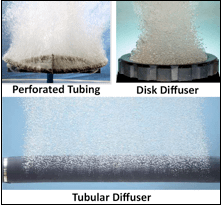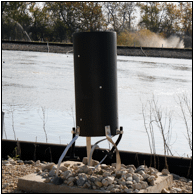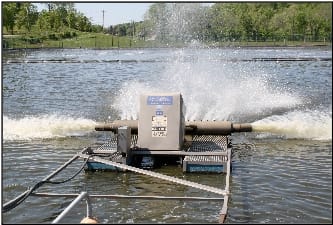Lagoon aeration can account for over 50 percent of energy costs, so efficiency is an important consideration in choosing aeration equipment and designing a system. In this episode of Lagoons Do It Better TV: Lagoon Aeration 101, our own Patrick Hill and Brady O’Leary give you the lowdown on different measures of efficiency, like SOTE and SAE. They highlight the importance of mixing in aeration and compare various technologies, namely fine and coarse bubble submerged aerators, surface aerators, and Triplepoint’s Ares Aerator®, in terms of oxygen transfer efficiency and O&M requirements.
Watch the video and read below for more details on the information presented. Then register for Lagoons Do It Better, our community for lagoon professionals!
SOTE: Standard Oxygen Transfer Efficiency
SOTE is the measurement of how much oxygen is transferred by a given aerator in clean water under the American Society of Civil Engineers’ testing standards. It is commonly used in aeration calculations to determine how much air is required to provide the necessary pounds/kilograms of oxygen needed for aerated lagoon treatment. The higher the percentage SOTE number, the less air is needed.
Bubble size is the single biggest factor in determining SOTE. The smaller the bubble, the higher the efficiency. This is due to the ratio of the bubble’s surface area to its volume, as well as the speed at which it rises through the water (the larger the bubble, the faster it rises).
SOTE, however, is not a calculation of energy efficiency, just of the mechanism of oxygen transfer: how efficiently the oxygen on the inside of the bubble gets conveyed into the water.
SOTE has a role to play in aerated lagoon efficiency because if less air is needed to provide the necessary oxygen, then potentially a lower blower horsepower is required. This can lead to lower energy costs. However, it is important to note that SOTE alone is not a measure of energy efficiency: backpressure together with the air requirement determines horsepower. For example, one fine bubble diffuser could have an SOTE of 3% per foot of depth, but have a higher operational backpressure than an alternative diffuser that is capable of 2% per foot. In that case, while the first diffuser will require less air to provide the necessary pounds of oxygen, it could require the same amount of horsepower/energy consumption as the second due to the blower having to work harder to overcome the additional backpressure.
SAE: Standard Aeration Efficiency
SAE is the parameter we use because it’s a combination of SOTE and blower horsepower, expressed as pounds of oxygen per horsepower hour. It is a more complete metric that allows different aerators’ energy efficiencies to be compared side by side, so you can evaluate the operating costs of different aerators in a particular aerated lagoon application. While SAE is rarely factored into the actual aeration calculations, it’s a good metric for directly comparing the energy efficiency of different technologies.
Difficulties with SOTE and SAE
There are a number of difficulties in making apples-to-apples comparisons of different aerators based solely on SOTE or SAE. For starters, there are different standards and methods for testing, both within the United States (ASCE), and abroad. Secondly, many aerator manufacturers advertise high SOTEs with very little data to back them up. (We’ve seen independent test results that came in at one-third to one-half of the manufacturer’s claims). An aeration system designer should never select equipment without certified independent lab results to confirm the manufacturer’s numbers. Preferably, the tests should be conducted by the same lab under the same conditions.
Moreover, the purpose of aeration in a wastewater lagoon system is more than just to add the necessary oxygen to water: it is also to mix. Mixing ensures that the organic matter, bacteria, and oxygen all come into contact with each other, thereby facilitating the wastewater treatment process. Without proper mixing, your lagoon could have the most energy-efficient aeration possible but still not achieve your effluent objectives. For more information on mixing see our article, Wastewater Mixing Alleviates Odor & Sludge Issues.
Fine Bubble vs. Coarse Bubble vs. Surface Aeration

Fine bubble aeration: Fine bubble diffusers, which produce uniform bubbles of about an eighth of an inch in size, are great at oxygen transfer but not so great at mixing. They create a fizzing action without turbulent mixing. These smaller bubbles have more contact area per volume of air, and they tend to climb the water column more slowly. This results in more oxygen transferred, more efficient lagoon aeration overall, and thus a higher SOTE and SAE. For fine bubble diffusers, the SAE can range from 4–7.0 lbs or more of oxygen per horsepower hour. For more information see our article, Fine Bubble Aeration in Wastewater Lagoons—Pros & Cons.

Coarse bubble aeration: Coarse bubble diffusers produce bubbles larger than a quarter of an inch in diameter. They are usually irregular and inconsistent, producing very large bubbles of an inch or two interspersed with smaller ones. Generally, coarse bubbles are regarded as effective mixers; however, they are less efficient than fine bubbles at providing the necessary oxygen because of the speed at which they rise through the water column. For coarse bubble diffusers, the SAE tends to be about 2–3.0 lbs. of oxygen per horsepower hour. See our article on Lagoon Coarse Bubble Aeration: Pros & Cons.

Ares Aeration®
Triplepoint developed the Ares lagoon aerator to harness the benefits of the various existing technologies while eliminating their drawbacks. Ares combines fine bubble diffusers for superior oxygen transfer efficiency with a coarse bubble static tube to provide robust mixing in a single portable unit.
Unlike surface aerators, Ares has no moving parts in the water to break and malfunction. Each self-weighted Ares unit is attached to an on-shore blower via flexible weighted tubing, then simply lowered into the water. Maintenance can be completed from the surface with no system downtime. And because it’s modular, the Ares system can be scaled to meet treatment needs.
Lagoons Do It Better: Join Us!
We believe in lagoons: They’re all we do. We believe that this effective, sustainable method of wastewater treatment should be preserved. That’s why we’ve been developing resources to help wastewater operators and engineers rehabilitate existing lagoon systems to meet modern effluent requirements as cost effectively as possible.
Subscribe to our YouTube channel, where we’ll be posting informational videos about various aspects of lagoon-based wastewater treatment.
Join our Lagoons Do It Better Facebook group, which we’re developing as a place where operators can meet to ask questions and access resources.
Become part of the Lagoons Do It Better community! Register on our website so we can keep you up-to-date with new resources and events and send you your own Lagoons Do It Better camo hat!


